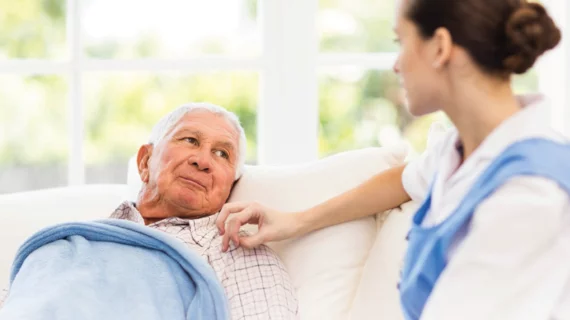The nature of caregiving means the caregiver-patient relationship is always changing, but continued support from a network of experts and dedication to mutuality and preparedness can ensure both patients and caregivers have a good quality of life (QoL), according to a study published Jan. 14 in Circulation: Cardiovascular Quality and Outcomes.
Mechanical circulatory support (MCS) has improved patients’ lives dramatically over the past two decades, Susan Magasi, PhD, and colleagues wrote, increasing their survival, improving their QoL and decreasing adverse outcomes. But both clinical guidelines and U.S. regulations require patients on MCS to choose a caregiver to assist with 24-hour support—something that’s often done hastily and with a degree of naivete.
When choosing whether they want to opt for a left ventricular assist device (LVAD) or move on to palliative care, critical heart failure (HF) patients often become anxious, perceiving the choice as a life-or-death decision they must make quickly, the authors said. With that kind of pressure, caregivers are hardly given the time to fully understand the physical, emotional, logistical and technical demands that come with being a full-time helping hand.
“Caregiving is demanding and can have a significant impact on caregivers’ health-related quality of life,” Magasi et al. wrote. “Caregivers may experience anxiety, depression, post-traumatic stress disorder, burden and worsening physical function. As a result, there is increasing recognition of the need to support MCS caregivers, both at implantation and long-term.”
Magasi and her team explored the relationship between patient and caregiver quality of life in a series of 30 semi-structured interviews, which involved both patients on MCS and their caregivers. All patients received MCS as either a bridge to heart transplantation or permanent implantation, and most had been living with an LVAD for more than six months.
The researchers found caregiving had a “profound” impact—both positive and negative—on patient and caregiver QoL. The early post-LVAD period was consistently a time of heightened anxiety for both parties, which Magasi et al. said was understandable since the pair were adjusting to demanding new routines, but those worries smoothed out within a matter of days or weeks as both patient and caregiver got used to their new workflow and adapted to a planning system.
A lot of what subjects described to Magasi and co-authors was positive, including a heightened sense of gratitude that they were able to go on MCS, decreasing their HF symptoms and giving them more time to live.
“He feels like he’s been given a second chance at life and he knows that I can’t live without him, so it has saved my life, as well,” one caregiver told the researchers. “It is the greatest blessing that we have ever received in our life.”
That kind of gratitude brought about positive change, since day-to-day care and increased time together strengthened the bond between patient and caregiver. One caregiver said she feels like her patient’s “shadow,” and neither view that as a burden.
That’s not always the case, though—a lack of mutuality and preparedness can spell trouble for caregivers and their patients, who might feel strained, tired and confined. A lack of communication and power struggles can make patients feel like they’ve lost their autonomy and caregivers can feel burdened and trapped. Magasi et al. said 43 percent of caregivers in their study discussed caregiver burden, and patients still reported feeling like a burden even when their caregivers denied feeling burdened themselves.
In a related editorial, Colleen K. McIlvennan, DNP, ANP, and Daniel D. Matlock, MD, MPH, wrote the healthcare industry is uniquely positioned to devise ways to help caregivers, but they likely won’t since healthcare systems aren’t incentivized to provide caregiver support.
McIlvennan and Matlock said one of the best ways to ease a caregiver’s sense of burden could be for the patient themselves to encourage their caregiver to practice self-care.
“Most caregivers assume they are responsible for all of the duties associated with caring for a patient with an LVAD, which leaves them little time to care for themselves,” they wrote. “Thus, at the level of the patient and caregiver, both parties need to be open to and seek out mental health and respite care when needed in addition to maintaining self-care.”
The editorialists said introducing multiple caregivers to break up the workload, creating better clinical decision support tools to help in shared decision-making and eventually implementing federal policies to support caregivers could help mitigate the situation.
“The burdens and complexities of caregiving are not a new problem,” McIlvennan and Matlock wrote. “Yet the burdens persist, and we must start pushing multiple stakeholders to initiate research, develop interventions and change policies that actually support caregivers of patients with LVADs in a meaningful way.”

